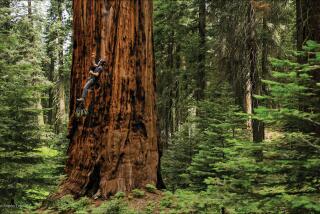Gift of O.C. parkland raises questions of affordability
The Irvine Co.’s plans to donate 20,000 acres of open space to the people of Orange County -- increasing parkland by more than half of its current size -- has encountered a seemingly unlikely opponent: environmentalists.
“Where’s the budget, where’s the money, and where’s the negotiating room?” said Jean Watt, president of Friends of Harbors, Beaches and Parks, at an Orange County Board of Supervisors meeting this fall where the donation was discussed. Watt was one of dozens of environmental activists who showed up to express doubts about the wisdom of the county’s plan to accept the donation.
“There’s no dichotomy about wanting the public lands,” Watt said later. “Everybody likes that idea. But only if you can afford them, if you can maintain them and if you can provide them to the public in a way that saves the ecosystem.”
The county, Watt and others say, doesn’t have the money to do any of that.
The land is relatively untouched in many areas, with steep canyons, oak woodlands and an uncommon native grassland. It’s also home to many rare and endangered species and includes a treasure trove of wildlife: great horned owls, golden eagles, mountain lions, red-tailed hawks, spadefoot toads, newts and seven species of bat.
Supervisors voted unanimously to move forward with the initial steps required to accept the land. The official transfer from the Irvine Co., a major local developer, to county ownership could occur early next year. By the end of March, the county parks department must give supervisors a long-term management and financial plan as well as provide legal documents necessary for the transfer.
Officials and environmentalists have waited more than a decade for the donation of land, which begins near the 91 Freeway and extends south to the hills north of Irvine, with parcels on both sides of the 241 toll road.
“This land transfer is something that’s been envisioned by resource managers . . . for years and years and years,” said Bert Ashland, chairman of the county’s Parks Commission. “It was originally supposed to happen in 1993 and 1994,” but then the county declared bankruptcy, making it unable to accept the donation.
The county isn’t the only one benefiting from the land transfer. The Irvine Co. is able to let go of a liability by donating the land and earns a possible multimillion-dollar tax write-off, critics say. Company officials, however, say the liability and potential write-off are minimal on such open-space property.
“We’ve pledged to do this, and we believe the timing is right,” said Dan Miller, the Irvine Co.’s senior vice president for entitlement and public affairs.
Unlike in most counties, Orange County’s parks department fund has been separate from the county general fund for years and receives a dedicated stream of property tax money, department Director Mark Denny said. Prior years of property boom have put the parks fund in a healthy state despite the recent economic downturn, enabling the department to accept the Irvine Co.’s donation, he said.
But environmentalists say that the county’s parks department recently identified about $30 million in improvements to make on its existing 39,000 acres of parkland and that for years the county has been reluctant to take on new property because of maintenance costs.
“We want this to work. We just want to make sure that those of us who have been around [conservation work] for a long time and involved with it make sure the county knows what the deal is,” said Pete DeSimone, manager of Audubon California’s Starr Ranch.
“This is a whole different ballgame, when you’re talking about habitat management and natural resources out there,” DeSimone said. The county, he said, needs to have a plan to manage the land before accepting it.
Nearly 9,000 acres of it are protected under the Natural Communities Conservation Plan, which requires them eventually to go to a public agency. And more than 11,000 acres -- which the Irvine Co. set aside in 2001 -- are protected under a conservation easement with the Nature Conservancy, which ensures their permanent preservation as open space.
Environmentalists point out, however, that a letter outlining plans for the transfer to county control states that all the acreage will be held under deed restrictions, a lesser protection. County officials said county policy prevents them from acquiring land from a private party that has a conservation easement.
Denny said the deed restrictions are still a strong safeguard because of the county’s park abandonment law, which is one of the strongest in the state. It requires multiple hearings and allows for a public referendum before land designated as parkland can be “abandoned” or rezoned for other use. “It’s a pretty strong protection for county parklands,” Denny said. “We’re fortunate to have it.”
The letter explains that the county has the option of having the Irvine Ranch Conservancy continue to manage the land for $1.5 million a year for up to a three-year transition period.
“Regardless of how the county chooses to manage the land, whether through a partnership with us or on their own, they have to find a way to fund that,” said Michael O’Connell, executive director of the Irvine Ranch Conservancy.
It is not clear how much of the parkland and its many former ranch trails will be open to the public once the transfer occurs. Last year the Irvine Ranch Conservancy had one public program a day on the land. O’Connell said the key will be finding a balance between access and protection of the land and its inhabitants.
“This is something we’ve got to move forward and snatch the opportunity,” Supervisor Bill Campbell said. “And make sure it is done well for all our people today, as well as for future generations.”
--
More to Read
Sign up for Essential California
The most important California stories and recommendations in your inbox every morning.
You may occasionally receive promotional content from the Los Angeles Times.










